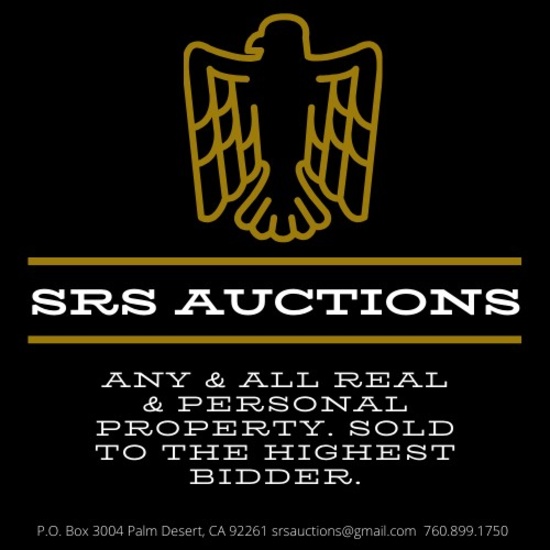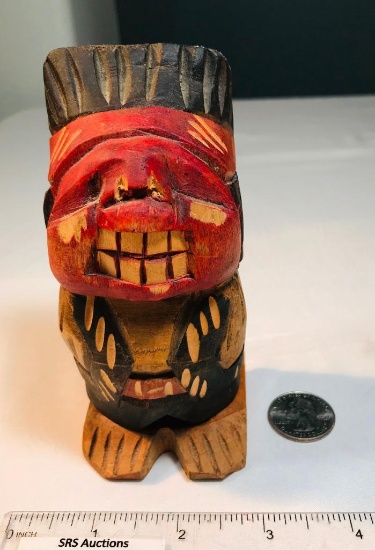
Guns, Ammo, US Coins, 50 Yrs Collecting Treasures!
Saturday, June 13, 2020 | 9:30 AM Pacific
Auction closed.
Guns, Ammo, US Coins, 50 Yrs Collecting Treasures!
Saturday, June 13, 2020 | 9:30 AM Pacific
Auction closed.
Internet Premium: 0% - 15%
See Special Terms for additional fees
Cash Payment Discount: 3%
See Special Terms for additional fees
Cash Payment Discount: 3%
Description
Guns, Ammo, Coins, Antique & Vintage Collectibles. Tools, Rich Household Items, & LOTS MORE...And specially prepared for you. SRS would like to thank you in advance for participating in our event. God Bless The USA.
Need help with bidding? Get Help
18th-19th Century Antique Indian Persian Bedouin Hammered Copper Tea Pot
Lot # 1088 (Sale Order: 81 of 470)
Hammered copper tea pot.
Bedouin, Persian , or Mughal Indian
Late 18th Century - early 19th century
The Width measures approx 7.5" with spout
6" in diameter not including spout.
$600-$800
Bedouin, Persian , or Mughal Indian
Late 18th Century - early 19th century
The Width measures approx 7.5" with spout
6" in diameter not including spout.
$600-$800
Antique Kings Norton Metal Company Hand Wrought Copper Saddle Stein
Lot # 1090 (Sale Order: 82 of 470)
KN Copper Stein
Circa 1890-1918
Birmingham, UK
Extremely rare.
$200-$300
An historical note on the King's Norton Metal Company Limited
Richard Chadwick
Any history of King's Norton Metal Company must begin with Thomas Richard Bayliss (1838-1914), its founder and director. Bayliss in 1862 married the daughter of John Abraham, who in that same year established the Adderley Park Mills in Saltley, Birmingham where, in addition to the production of brass and copper rolled strip, machinery was installed for making percussion caps, and other drawn products for the ammunition trades. Under the direction of Bayliss the ammunition business was further developed,
and plant was designed to produce deep drawn brass cases for military small arms ammunition. In 1873 the Adderley Park Mills were acquired by the Birmingham Small Arms Company. There Bayliss, as managing director, brought cartridge case manufacture onto a production basis, and in the late 1870s was instrumental in the supply of 50 million rounds of 0.303in ammunition for the then new German Mauser rifle. Bayliss also personally supervised the installation of plant in Germany for further manufacture.
The adoption by the British Government of infantry weapons based on the 0.303in solid-drawn brass case, and then of the larger brass case for the Nordenfelt six- pounder quick firing gun, was the signal for Bayliss to sever his connection with BSA, and start the building of a factory in Lifford Lane, King's Norton, on the banks of the Birmingham and Worcester canal, outside the boundary of Birmingham City, and within easy reach of his residence at Belmont on the Bristol Road at Northfield. The site, of some 27 acres, was skilfully chosen, since there was then ample space for future expansion, while also metal ingots, for his rolling mills and other planned future requirements, as well as coal for the extensive steam-raising plant, could be brought in by barge. Tall chimneys erected at that time must have been a conspicuous feature. As early as 1900 an additional 30 acres was taken in, and the size of the works doubled. At that time also a site of some 60
acres was acquired at Abbey Wood on the South Bank of the Thames adjoining Woolwich Arsenal. Metal components produced at King's Norton were despatched there for assembly and loading, with direct access to the Arsenal for supplies to British Government orders, and to adjoining docks for shipment overseas. The handUng of explosive materials at King's Norton was thus completely avoided.
Of the many plant items, large and small, driven by individual steam engines, only rolling mills can be mentioned here. No. 1 rolling mill, installed in 1890, and No. 2 mill, installed in 1900 would each have comprised several stands, separately driven by steam engine through a train of heavy gears, as was general
practice at that time, and is revealed in photographs of the plant. Both mills were kept working night and day to provide strip of copper, brass and other alloys, needed by the King's Norton plant itself for the manufacture of cartridge cases and other components, as well as for export to the several overseas countries where plant of Bayliss design had been installed.
In 1914, with the prospect of war on the horizon, a new rolling mill was laid down comprising six stands linked in pairs, and driven by three electric motors through fully enclosed gear trains, a design much ahead of its time. During the 1914-1918 period this mill regularly produced 500 tons/week of cartridge metal strip. Early in this same period extrusion presses were installed primarily to produce rod for fuse bodies, but King's Norton Metal was one of the first companies to offer extruded rod in round, square, hexagon and other shapes. Over the war period some 2,000 people were employed in the King's Norton Works alone.
Bayliss sought always to achieve the highest quality. To this end he employed qualified scientific and technical staff, and it is pertinent to note that the first published scientific paper on the production of cartridge metal strip, by Dr H W Brownsdon, appeared in 1917. A subsequent paper laid down procedures for the technical investigation of works problems by qualified and trained staff, employing standards more in accord with present practice, and well in advance of contemporary thinking.
From early in the century King's Norton Metal were producers of high quality blanks for coin manufacture, and in 1912 a complete minting plant was installed, licensed to produce coins with the K N mint mark. After the war King's Norton came to the assistance of the Royal Mint, and under the 1918 and 1919 date-marks some 5 million pennies with the K N mint-mark were
put into circulation. Extant coins of this issue are now to be found in the possession of collectors and museums.
Although the King's Norton company never entered the sporting cartridge industry, it is evident that Bay
Circa 1890-1918
Birmingham, UK
Extremely rare.
$200-$300
An historical note on the King's Norton Metal Company Limited
Richard Chadwick
Any history of King's Norton Metal Company must begin with Thomas Richard Bayliss (1838-1914), its founder and director. Bayliss in 1862 married the daughter of John Abraham, who in that same year established the Adderley Park Mills in Saltley, Birmingham where, in addition to the production of brass and copper rolled strip, machinery was installed for making percussion caps, and other drawn products for the ammunition trades. Under the direction of Bayliss the ammunition business was further developed,
and plant was designed to produce deep drawn brass cases for military small arms ammunition. In 1873 the Adderley Park Mills were acquired by the Birmingham Small Arms Company. There Bayliss, as managing director, brought cartridge case manufacture onto a production basis, and in the late 1870s was instrumental in the supply of 50 million rounds of 0.303in ammunition for the then new German Mauser rifle. Bayliss also personally supervised the installation of plant in Germany for further manufacture.
The adoption by the British Government of infantry weapons based on the 0.303in solid-drawn brass case, and then of the larger brass case for the Nordenfelt six- pounder quick firing gun, was the signal for Bayliss to sever his connection with BSA, and start the building of a factory in Lifford Lane, King's Norton, on the banks of the Birmingham and Worcester canal, outside the boundary of Birmingham City, and within easy reach of his residence at Belmont on the Bristol Road at Northfield. The site, of some 27 acres, was skilfully chosen, since there was then ample space for future expansion, while also metal ingots, for his rolling mills and other planned future requirements, as well as coal for the extensive steam-raising plant, could be brought in by barge. Tall chimneys erected at that time must have been a conspicuous feature. As early as 1900 an additional 30 acres was taken in, and the size of the works doubled. At that time also a site of some 60
acres was acquired at Abbey Wood on the South Bank of the Thames adjoining Woolwich Arsenal. Metal components produced at King's Norton were despatched there for assembly and loading, with direct access to the Arsenal for supplies to British Government orders, and to adjoining docks for shipment overseas. The handUng of explosive materials at King's Norton was thus completely avoided.
Of the many plant items, large and small, driven by individual steam engines, only rolling mills can be mentioned here. No. 1 rolling mill, installed in 1890, and No. 2 mill, installed in 1900 would each have comprised several stands, separately driven by steam engine through a train of heavy gears, as was general
practice at that time, and is revealed in photographs of the plant. Both mills were kept working night and day to provide strip of copper, brass and other alloys, needed by the King's Norton plant itself for the manufacture of cartridge cases and other components, as well as for export to the several overseas countries where plant of Bayliss design had been installed.
In 1914, with the prospect of war on the horizon, a new rolling mill was laid down comprising six stands linked in pairs, and driven by three electric motors through fully enclosed gear trains, a design much ahead of its time. During the 1914-1918 period this mill regularly produced 500 tons/week of cartridge metal strip. Early in this same period extrusion presses were installed primarily to produce rod for fuse bodies, but King's Norton Metal was one of the first companies to offer extruded rod in round, square, hexagon and other shapes. Over the war period some 2,000 people were employed in the King's Norton Works alone.
Bayliss sought always to achieve the highest quality. To this end he employed qualified scientific and technical staff, and it is pertinent to note that the first published scientific paper on the production of cartridge metal strip, by Dr H W Brownsdon, appeared in 1917. A subsequent paper laid down procedures for the technical investigation of works problems by qualified and trained staff, employing standards more in accord with present practice, and well in advance of contemporary thinking.
From early in the century King's Norton Metal were producers of high quality blanks for coin manufacture, and in 1912 a complete minting plant was installed, licensed to produce coins with the K N mint mark. After the war King's Norton came to the assistance of the Royal Mint, and under the 1918 and 1919 date-marks some 5 million pennies with the K N mint-mark were
put into circulation. Extant coins of this issue are now to be found in the possession of collectors and museums.
Although the King's Norton company never entered the sporting cartridge industry, it is evident that Bay
Vintage Three Dancing Women Statue P.A.T / T.L
Lot # 1091 (Sale Order: 83 of 470)
Three Women Statue. Engraved P.A.T and T.L
Approx. 11" tall x 8" wide.
Please see pictures for condition.
Approx. 11" tall x 8" wide.
Please see pictures for condition.
Vintage Hand Carved Wood Ceremonial Shepherd?s Wedding Cup Adlin, Yugoslavia
Lot # 1093 (Sale Order: 85 of 470)
Naughty VTG Wood Hand Carved Indian Funny Naked Unique Risque Penis
Lot # 1098 (Sale Order: 90 of 470)
Indian Penis needs repair or Viagra, it is not going up
German Beer Steins
Lot # 1099 (Sale Order: 91 of 470)
Two Tall Steins 11" Tall
One Small Stein 5.5" Tall
Used
One Small Stein 5.5" Tall
Used


 x Cancel
x Cancel























